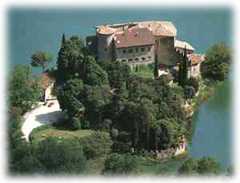Toblino Castle
 Toblino Castle is situated around the Lake Toblino and is the most
romantic castle in Trentino.
Toblino Castle is situated around the Lake Toblino and is the most
romantic castle in Trentino.Noted for its romantic legends and for the indolent holidays of the Bishop’s Court, Toblino Castle is a rare example in Trentino of a lake fortification. Originally it was probably a prehistoric, then Roman, fortified village, built on a large island in the lake which, when the water level dropped, became a peninsula. Walled into the castle’s portico is a stone, of some significance for the rarity of the type of inscription, which states that here in the third century AD there was a small temple dedicated to the worship of the Fates (related to the Tublinates tribe?). Very soon the original religious purpose of the site became a military one, given its strategic position. In the thirteenth century the Lords of Toblino were deprived of power by the Lords of Campo from Campo Castle in the Giudicarie valley. Later the castle was expropriated by the Church of Trento (1459) and Cardinal Bernardo Clesio had it rebuilt (1536-7) in the Renaissance style; certain of the artists employed to work on the Magno Palazzo in Buonconsiglio Castle also worked here.
The predominating sixteenth century elements are the result of modifications made by Gian Gaudenzio Madruzzo (the courtyard colonnade and open gallery and the round arches). The earlier mediaeval style can be seen in the western wall (three metres thick) and in the small tower in the north-west part of the perimeter wall. The round tower, almost the symbol of the castle, is twenty metres high and acted as a keep by strengthening the wall which closed off the top of the fortified crag of rock.
In 1703 the castle suffered the same fate as all the others in the Sarca valley that lay in the path of General Vend˘me’s troops. In 1848 it was the stronghold of the Italian Free Corps, who were attempting to bring Trentino under Italian rule and who were defeated by the Austro-Hungarians. Finally, through marriage, it became the property of the Wolkestein family. At the beginning of this century it was launched as a tourist attraction, capitalising on its excellent vinsanto and on a legend of forbidden love involving the last mrmber of the Madruzzo family, Carlo Emanuele. The castle has always exerced a certain charm and has figured in the writing of authors such as Antonio Fogazzaro, Ada Negri and the German poet Scheffel. It has been partly converted into a restaurant.